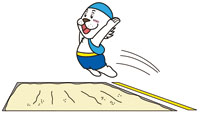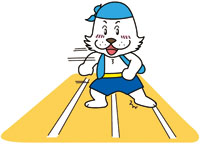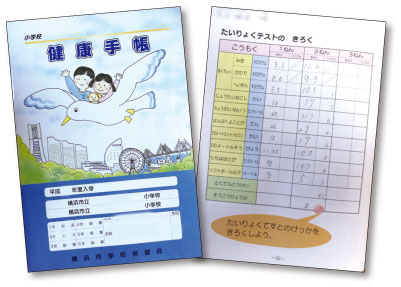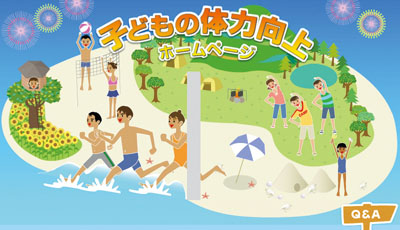SPORTS YOKOHAMA Vol.39 : Feature(2/3)

The New Physical Test is conducted to examine the physical fitness and athletic performance of people from children to adults.
In the test, participants are classified into four age groups: elementary school boys and girls aged between 6 and 11 (in all elementary school grades), men and women aged between 12 and 19, men and women aged between 20 and 64, and men and women aged between 65 and 79.
Elementary school pupils are tested in eight types of exercise.
Grip strength Muscle power: Ability of muscle to generate force
Sit-up Muscle power/muscle endurance: Abilities of muscle to generate and maintain force
Sitting trunk stretch Flexibility: Ability to bend and stretch the body
Side step Agility: Ability to repeat a specific type of exercise rapidly
20-meter shuttle run Whole-body endurance: Ability to continue to exercise with the whole body
50-meter sprint Speed: Ability to move fast
Standing long jump Instantaneous force: Ability to start to move quickly
Ball throw Motor skill/instantaneous force: Abilities to regulate movement and start to move quickly
Since test results are scored for each type of exercise on a scale of 1 to 10, participants can find out which of their abilities are superior and which are inferior. They are also rated on a five-point scale (A to E) according to age, allowing them to check their physical fitness level against the national average of their respective age groups.


 Municipal elementary and junior high schools in Yokohama City record physical test results along with health checkup results and other growth-related data in the health handbook distributed to every pupil and student. Since many schools store health handbooks on their premises, there may be few occasions when parents have access to the health handbooks of their children. But these health handbooks are instrumental in health management and guidance.
Municipal elementary and junior high schools in Yokohama City record physical test results along with health checkup results and other growth-related data in the health handbook distributed to every pupil and student. Since many schools store health handbooks on their premises, there may be few occasions when parents have access to the health handbooks of their children. But these health handbooks are instrumental in health management and guidance.
The National Recreation Association of Japan runs a website intended to enhance the physical fitness of children. When a visitor enters the New Physical Test results of his or her child, the website displays the entered data in graph form. Other features of this website include a web page for learning by parents and children and a list of national averages and other numerical values.
While the New Physical Test is not meant to rank individuals, the test results help you find out about the physical fitness and athletic performance of your children by comparing their scores with the national averages. Also, displaying your children’s test results in graph form lets you identify which types of exercise they are good at and which types of exercise they are poor at.

Website for enhancing the physical fitness of children

The New Physical Test is conducted to examine the physical fitness and athletic performance of people from children to adults.
In the test, participants are classified into four age groups: elementary school boys and girls aged between 6 and 11 (in all elementary school grades), men and women aged between 12 and 19, men and women aged between 20 and 64, and men and women aged between 65 and 79.
Elementary school pupils are tested in eight types of exercise.
Grip strength Muscle power: Ability of muscle to generate force
Sit-up Muscle power/muscle endurance: Abilities of muscle to generate and maintain force
Sitting trunk stretch Flexibility: Ability to bend and stretch the body
Side step Agility: Ability to repeat a specific type of exercise rapidly
20-meter shuttle run Whole-body endurance: Ability to continue to exercise with the whole body
50-meter sprint Speed: Ability to move fast
Standing long jump Instantaneous force: Ability to start to move quickly
Ball throw Motor skill/instantaneous force: Abilities to regulate movement and start to move quickly
Since test results are scored for each type of exercise on a scale of 1 to 10, participants can find out which of their abilities are superior and which are inferior. They are also rated on a five-point scale (A to E) according to age, allowing them to check their physical fitness level against the national average of their respective age groups.


 Municipal elementary and junior high schools in Yokohama City record physical test results along with health checkup results and other growth-related data in the health handbook distributed to every pupil and student. Since many schools store health handbooks on their premises, there may be few occasions when parents have access to the health handbooks of their children. But these health handbooks are instrumental in health management and guidance.
Municipal elementary and junior high schools in Yokohama City record physical test results along with health checkup results and other growth-related data in the health handbook distributed to every pupil and student. Since many schools store health handbooks on their premises, there may be few occasions when parents have access to the health handbooks of their children. But these health handbooks are instrumental in health management and guidance.
The National Recreation Association of Japan runs a website intended to enhance the physical fitness of children. When a visitor enters the New Physical Test results of his or her child, the website displays the entered data in graph form. Other features of this website include a web page for learning by parents and children and a list of national averages and other numerical values.
While the New Physical Test is not meant to rank individuals, the test results help you find out about the physical fitness and athletic performance of your children by comparing their scores with the national averages. Also, displaying your children’s test results in graph form lets you identify which types of exercise they are good at and which types of exercise they are poor at.

 ハマスポ
ハマスポ
 お知らせ&トピックス
お知らせ&トピックス
 ページトップへ戻る
ページトップへ戻る ページトップへ戻る
ページトップへ戻る

